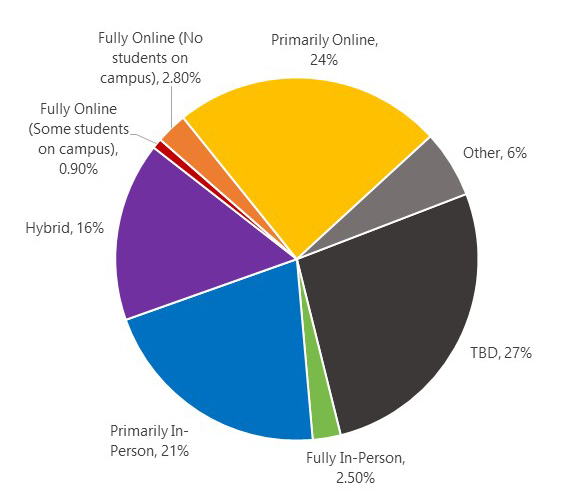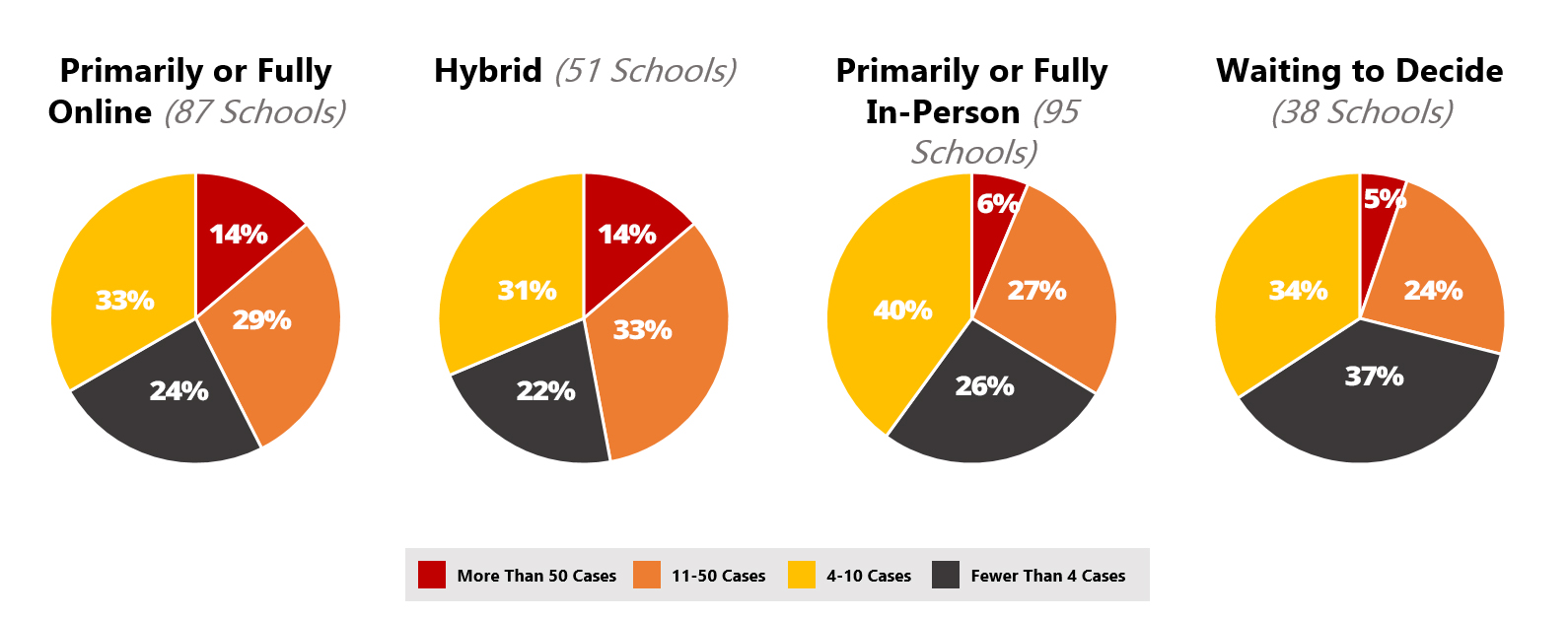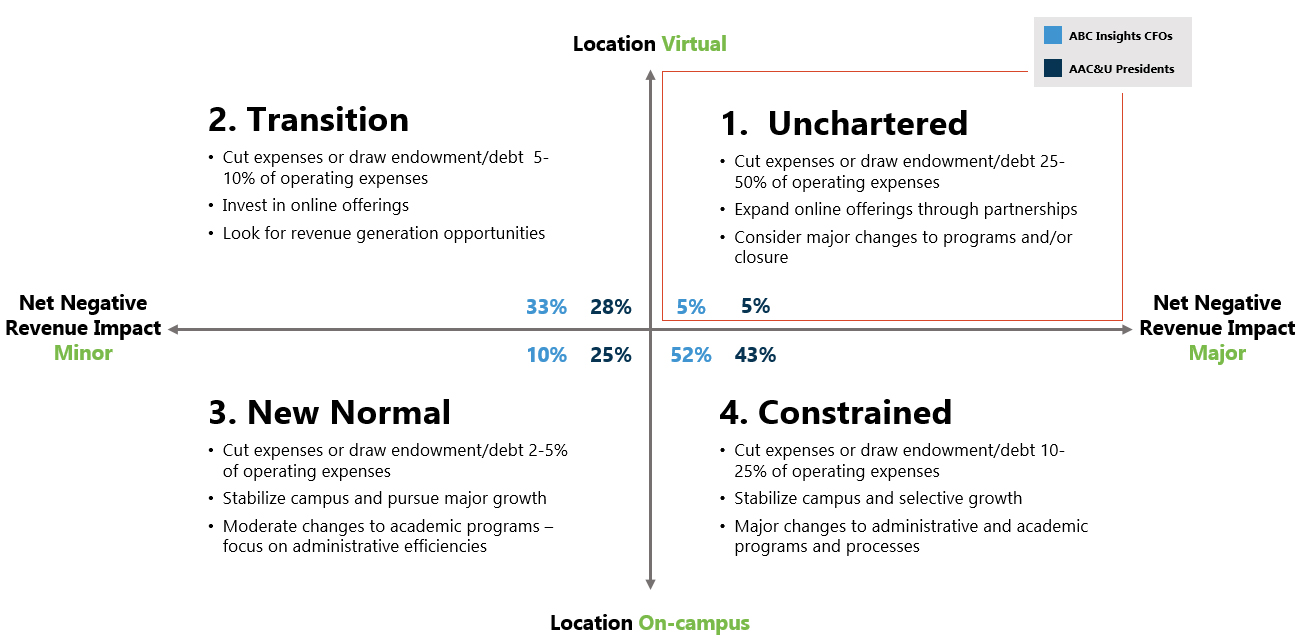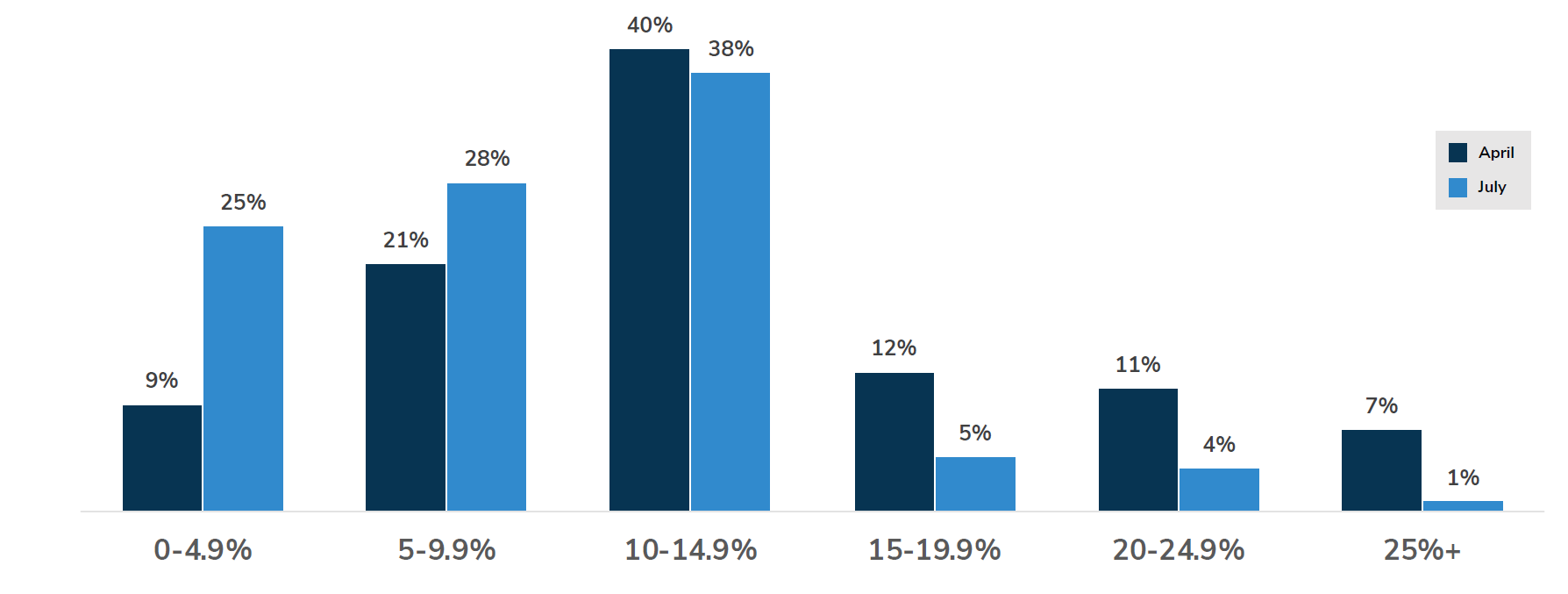UNC is Preparing for the Worst-case Scenario (and Why You Should, Too)
This past March, in an article on scenario planning for coronavirus, I predicted that if the pandemic continued to spread and led to a severe recession, higher education institutions could be facing up to a 50% cut to budgets.1 My hope was that it would not become reality; unfortunately, it remains a possibility. The UNC Board of Governors reportedly asked all universities in the system to outline what changes they would make to their budgets should they be faced with a 25% and 50% cut to resources.2 (Note that some reports are that this request was actually a request for changes if enrollments dropped by those percentages, rather than the overall budget.) Either way, it is clear that UNC and all universities are preparing for uncharted territory as we approach our fall semester.
And for good reason. This year is going to be the most challenging period in the history of higher education. The tsunami facing us is driven by the health crisis of COVID-19, the resulting economic impact of our recession, such as the 9% drop in GDP last quarter or 33% annualized, and the expected racial justice protests sweeping our country. Using the UNC system as an example, this article explores the topic of scenario planning and drills down specifically into the potential negative impact on universities as well as potential policy and strategic actions to mitigate the damage.

Source: Chronicle of Higher Education
Especially concerning are the potential ramifications of bringing so many students back to campus during a high point in virus outbreaks. We need to look at this strategically. On the national level (see Colleges’ Reopening Plans in the Fall), and tracked by The Chronicle of Higher Education, only 24% of higher education institutions plan to open in the fall either fully or primarily in person. The vast majority are planning some combination of primarily to partially online and another 33% are still working on their decision.3
The motivations for opening in person include the desire of many students, the goal of providing a fuller educational experience, utilization of campus assets and the financial impact of potential lower enrollments and loss of tuition and fees.4 Other universities have concluded that the risks of bringing students back are just too great based on the current state of COVID-19 cases nationwide and the likelihood of outbreaks on campus given the highly interactive nature of the college experience, even with great efforts to require masks and social distancing.5 Almost all universities closed campuses in the spring and summer and switched to remote instruction.
Recently, some students have been returning to campus and COVID-19 is coming with them. The New York Times reported that more than 6,300 cases have been reported at just 270 colleges over the course of the pandemic, including student-athletes returning to prepare for fall sports.6 Shown below is cross-listing of the reported cases sorted by general reopening strategy.

Source: The New York Times and The Chronicle of Higher Education
While the above data indicate that schools with more cases are leaning toward more fully online strategies, we are very early in this data collection effort. We do have several other situations where outbreaks of cases on a campus have affected the decision to move online, including the University of Washington and the University of California at Berkeley.7
When universities bring large numbers of students back to campus, there will be outbreaks. In fact, UNC-Chapel Hill has already reserved two residence halls to house students who test positive.8 Community spread varies by state and community, but even if only 5% of returning students test positive, there could be 7,000 new cases in North Carolina as approximately 140,000 students arrive on 17 campuses over the next few weeks. For perspective, the entire state of North Carolina has reported 114,000 cases thus far, and we are considered a “hot spot” state.9
The universities are doing everything they can to mitigate the risk on campus and spending millions of dollars to do so. Early evidence suggests that our younger population is growing significantly in terms of positive cases and, when in close proximity, are likely to spread it.10 Thousands of UNC faculty have signed petitions to reverse the decision of opening in person and instead return to virtual instruction—the logic being that the situation is as bad, if not worse, than it was in the spring when we did shut down the physical campus.11 Given the many cases expected on a campus, the risk of exposure and infection is significant for faculty who are older or otherwise at high risk. I am 54 and diabetic and received approval from HR to teach remotely this fall, but I fear for my colleagues as well as my students and their families.
Given all of this, it is time to start preparing for the worst-case scenario. Shown below is a scenario plan that I created in May to summarize and evaluate potential situations based upon two key dimensions – percent of students physically on campus and the magnitude of the negative financial impact facing an institution to help budget creation. Leaders can use this to identify a base case (expected) and a worst case (potential). The percentages included in the inner core of the quadrants represent survey results from CFOs in April and college and university presidents in July.

Source: Dr. Paul N. Friga in the Chronicle of Higher Education; ABC Insights AAC&U Survey of Presidents, July 12, 2020 n=119; ABC Insights Survey of CFOs, April 30 2020 n=21
To assess your own university’s base-case quadrant, the decision on the percent of students physically on campus may already be made. Each day, more universities are switching to an online format as they assess their local conditions, guidance and risk tolerance. The financial assessment is driven by a calculation of cuts to state support, decreases in enrollments, potential cuts to tuitions and fees, and increased expenses related to handling the virus on campus.
While only 5% of the campus leaders anticipate Quadrant 1 “Unchartered,” a predominantly virtual instruction model that comes with major negative revenue impact, I recommend that all universities begin planning for just such an outcome. The intent of this strategy tool is to begin formulating shifts to strategy amid a rapidly changing environment—and I actually believe that this scenario is more likely than current leaders would like to think. Higher education has never experienced anything like this, and though certain public universities have been dealing with decreasing state funding, many of them have been able to make up for diminished resources with tuition increases.12 With student debt at $1.6 trillion and higher education costs out of reach for many families, tuition increases are not likely to be a viable strategy to survive this crisis.13
Let’s explore the potential negative impact of the worst-case scenario on the UNC system. Shown below is a snapshot of the universities’ demographic data. The columns to the right illustrate the impact if each university were to eliminate 25% or 50% of their employee base. The effect of such layoffs would be devastating for those employees and, in some cases, for the communities surrounding our smaller campuses. Can you imagine the impact of losing half your workforce—which equates to over 7,000 employees from UNC-Chapel Hill alone?

Source: IPEDs, 2018
Another way to explore the cuts would be to examine the impact of budgets. Shown below is a snapshot of the amount of funding which would be cut from each university under both a 25% and 50% decrease scenario.

Source: IPEDs, 2018
The final decision would be where to make the cuts. Assuming across-the-board-cuts based upon dollars spent (which is one of the worst strategic approaches to take), here is how much would be cut by expense category. (A better approach would be to benchmark all of these areas against peers to identify where over- and perhaps even under-investment occurs. Investments should also be tied to specific strategic priorities, as moves made during tough economic times allow for bigger gains as the recession ends.)

Source: IPEDs, 2018
The bottom line is that the impact is going to be quite significant—almost unimaginable. The University of Michigan, for instance, is estimated to lose $1 billion this year alone.14 Shown below is the estimated negative financial impact based upon a survey just completed by ABC Insights and AAC&U.

Source: ABC Insights & rpk GROUP Survey of AAC&U Presidents’ Trust; April 1, 2020; n=142, ABC Insights Survey of AAC&U Presidents’ Trust; July 12, 2020; n=119
So what can be done? The purpose of scenario planning is to get an early jump on the types of actions that may be necessary should a dynamic situation shift one way or another. I posit that this situation is going to shift from bad to worse in the fall and most universities will be forced to switch to remote delivery—meaning lost revenues due to lowered tuitions, enrollments, football and sporting events, auxiliary services and state support. Universities have already incurred significant expenses due to COVID-19 preparation and will incur even more due to additional online technical support, operational changes and even lawsuits.
Here is a list of potential actions for universities, the system and policymakers to consider. These proposed actions are not intended to be mutually exclusive, nor is the list collectively exhaustive—rather, it should serve as a starting point.
University-level strategies:
- Cut administrative expenses: Implement hiring freezes and furloughs; cut salaries of top administration, coaches and faculty; use benchmarking data to identify where spend is higher than the average of peers; analyze FTE levels and eliminate redundant positions; increase centralization; consolidate vendors; and implement zero-based budgeting to have each activity area build up its most critical value-add and investment areas.
- Restructure academics: Conduct a portfolio review of all offerings; sunset low-enrollment or non-critical programs; increase faculty productivity; decease/monitor leave arrangements; and consider increasing teaching loads.
- Grow revenues: Invest in online programming for now and the future; expand fundraising efforts; and launch new programs that are more in demand.
University system-level strategies:
- Reverse course: Change the decision on school openings to avoid risk of death and lawsuits.
- Push for efficiency: Sponsor efficiency studies across all campuses based upon data and benchmarking to find cost savings opportunities.
- Consolidate operations: Consider consolidating back-office functions (such as IT and HR) for all universities and even merging smaller schools to decrease duplicative overhead and facilities costs.
Policymaker strategies:
- Provide support: Access the $1billion state reserve fund to pay for this rainy day and make changes that will be beneficial in the long run.
- Require accountability: Demand more efficient and effective universities and curtail increasing per-student spending for the short term.
- Seek help: Lobby lawmakers to obtain more money for state support to make up for lost revenues and avoid cuts to public higher education (see my article proposing an $81 billion investment by the U.S. Congress to transform higher ed.)15
This is an unprecedented period for our universities and, as such, will require unprecedented strategies to navigate it. We must all work together as collaboratively as possible and always keep the health of our people and the outcomes for our students in mind. While the financial impacts are going to be quite dramatic, we should also do our best to invest in core mission activities and even move forward on new priorities to make overdue changes to how we deliver education—and how much we charge to do it. Transforming higher education will not be easy, but summoning visionary leadership today will ensure we can not only survive, but thrive, during and beyond this crisis.
1Paul Friga, “Scenario Planning for Coronavirus,” Inside Higher Ed https://www.insidehighered.com/views/2020/03/13/using-strategic-thinking-and-scenario-planning-deal-coronavirus-opinion
2Joe Killian, “UNC schools begin responding to potential budget cuts of up to 50 percent,” The Progressive Pulse http://pulse.ncpolicywatch.org/2020/07/21/unc-schools-begin-responding-to-potential-budget-cuts-of-up-to-50-percent/
3“Here’s Our New List of Colleges’ Reopening Plans,” The Chronicle of Higher Education https://www.chronicle.com/article/Here-s-a-List-of-Colleges-/248626
4Christina Paxson, “College Campuses Must Reopen in the Fall. Here’s How We Do It,” The New York Times https://www.nytimes.com/2020/04/26/opinion/coronavirus-colleges-universities.html
5Nell Gluckman, “What’s Behind Colleges’ Bullish Statements on Their Fall Plans?” the Chronicle of Higher Education https://www.chronicle.com/article/whats-behind-colleges-bullish-statements-on-their-fall-plans/?cid=gen_sign_in
6“The Coronavirus Outbreak” The New York Times https://www.nytimes.com/2020/07/29/world/coronavirus-covid-19.html
7Lindsay Ellis, “Colleges Hoped for an In-Person Fall. Now the Dream is Crumbling.” The Chronicle of Higher Education https://www.chronicle.com/article/colleges-hoped-for-an-in-person-fall-now-the-dream-is-crumbling
8“Carolina Together – Roadmap to Fall 2020 – Housing FAQs” UNC Student Affairs https://housing.unc.edu/carolina-together-roadmap-fall-2020-housing-faqs
9Bailey Aldridge, Simone Jasper, “Coronavirus live updates: Here’s what to know in North Carolina on July 30,” The News & Observer https://www.newsobserver.com/news/coronavirus/article244584477.html
10Jennifer Senior, “I Spoke With Anthony Fauci. He Says His Inbox Isn’t Pretty,” The New York Times https://www.nytimes.com/2020/07/21/opinion/anthony-fauci-coronavirus.html?referringSource=articleShare
11Kate Murphy, “UNC faculty want more protection and COVID-19 testing before returning to campus,” The News & Observer https://www.newsobserver.com/news/local/education/article243371691.html
12Andrew DePietro, “Impact of Coronavirus on College Tuition And Finances,” Forbes https://www.forbes.com/sites/andrewdepietro/2020/06/02/impact-covid-19-tuition-finance/#760817c94b88
13Christopher Ingraham, “7 ways $1.6 trillion in student loan debt affects the U.S. economy,” The Washington Post https://www.washingtonpost.com/business/2019/06/25/heres-what-trillion-student-loan-debt-is-doing-us-economy/
15Paul N. Friga, “How Congress Can Save College”, The Chronicle of Higher Education, https://www.chronicle.com/article/how-congress-can-save-colleges/?cid2=gen_login_refresh&cid=gen_sign_in
- Keyword(s):
- covid-19 192
- higher education 18
- vaccine 17
